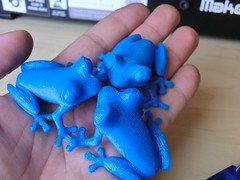If you haven’t tried 3D printing yet, you most likely will give it a try in the next couple of years. Rapid Prototyping interest is skyrocketing not only for businesses, but even retail futurists are looking to a time when we’ll have 3D printing down at the local print shop and perhaps even in our own home offices.
Recently, one Oakland neighborhood printer, HoneyBee3D, opened its doors to offer rapid prototyping, printer tools and 3D printers for sale. For most people, a sizable investment is required to try this new technology. But the investment benefits are many in the long run. For instance, 3D rapid prototyping costs the same whether you create one or many, and it’s just a fraction of traditional manufacturing, with a shorter lead time. Also 3D printing is better for the environment, which is extremely attractive to those who are environmentally savvy.
3D printing is an exciting process when you consider what it looks like. Imagine a single spaghetti-like string of plastic comes out of a heated chamber as a thin molten line of plastic. Layer by layer those strings slowly build on one another until the result is your desired shape of an object you’ve created.
Users are limited only by their creativity, and can design on the fly just by modifying the computer file to change the shape, size and structure.
How popular will rapid prototyping become? By year’s end, worldwide shipments of 3D printers priced less than $100,000 are expected to grow 49 percent. And by this time next year the growth will nearly double. As with any technology, costs are expected to eventually decrease. This year corporations around the world will spend more than $325 million, while consumers will spend $87 million. Futurists say that the combined corporate/consumer spending will increase 62 percent for 3D printing.
Corporations, governments and manufacturers are already using this technology for new innovations in architecture, defense and medical products. I believe consumers will eventually evolve from curiosity to finding exciting reasons to justify purchases, as more of us find new ways to use rapid prototyping in our everyday lives.


